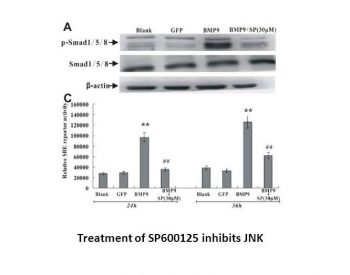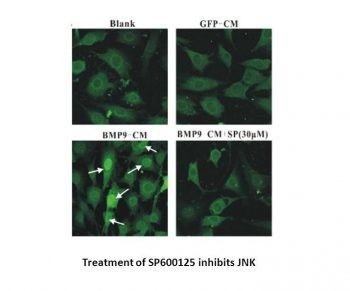
| Size | Price | Stock | Qty |
|---|---|---|---|
| 10mg |
|
||
| 50mg |
|
||
| 100mg |
|
||
| 250mg |
|
||
| 500mg |
|
||
| 1g |
|
||
| 2g |
|
||
| Other Sizes |
|
Purity: =100%
| Targets |
serine/threonine kinase ; JNK1 (IC50 = 40 nM); JNK2 (IC50 = 40 nM); Aurora A (IC50 = 60 nM); TrkA (IC50 = 70 nM)
|
|---|---|
| ln Vitro |
SP600125 is originally characterized as a selective ATP-competitive inhibitor of c-Jun N-terminal kinase JNK. With an IC50 range of 5 to 10 mM, SP600125 prevents the phosphorylation of c-Jun in Jurkat T cells. With an IC50 of 5 μM to 12 μM, SP600125 inhibits the expression of inflammatory genes COX-2, IL-2, IL-10, IFN-γ, and TNF-α in CD4+ cells, such as Th0 cells isolated from either human cord or peripheral blood. It also blocks cell activation and differentiation. [1] Later research, however, has shown that SP600125 also inhibits aryl hydrocarbon receptor AhR) [2], Mps1 [3], and a panel of other serine/threonine kinases, including Aurora kinase A, FLT3, MELK, and TRKA[4]. In mouse beta cells, MIN6 (20 M) stimulates the phosphorylation of p38 MAPK and the activation of its downstream CREB-dependent promoter. [5] SP600125 (20 M) blocks the transition from the G2 phase to mitosis and causes endoreplication in HCT116 cells. This capability of SP600125 results from its inhibition of CDK1-cyclin B activation upstream of Aurora A and Polo-like kinase 1, not from its inhibition of JNK. [6]
|
| ln Vivo |
SP600125 (15 mg/kg or 30 mg/kg) significantly reduces the expression of TNF- induced by lipopolysaccharide (LPS) and the apoptosis of CD4+ CD8+ thymocytes induced by anti-CD3 in mice. [1]
|
| Enzyme Assay |
Based on the precise measurement of radioactive phosphotransfer to the substrate, SP600125's potency towards kinases such as MPS1, JNK, and Aurora kinase A is established. The optimal [ATP] (2Km) and [substrate] (5Km) concentrations are then used in each assay to determine the absolute Km values for ATP and the particular substrate for each enzyme. MPS1 activity is measured using 5 nM of MPS1 recombinant protein in 50 mM HEPES pH 7.5, 2.5 mM MgCl2, 1 mM MnCl2, 1 mM DTT, 3 μM NaVO3, 2 mM β-glycerophosphate, 0.2 mg/mL BSA, 200 μM P38-βtide substrate-peptide (KRQADEEMTGYVATRWYRAE), and 8 μM ATP with 1.5 nM 33P-γ-ATP. The IC50 of ten serial 1:3 dilutions of SP600125 (ranging from 30μM to 1.5 nM) is tested.
|
| Cell Assay |
In 384 well plates, cells are sown. The cells are given SP600125 treatment for 72 hours after seeding, and the plates are then processed using a CellTiter-Glo assay. The IC50 value for proliferation is calculated after the inhibitory activity is assessed by comparing treated versus control data.
|
| Animal Protocol |
Mice: Female CD-1 mice (8–10 weeks old) are administered a dose of SP600125 intravenously (IV) or orally (OS) in a PPCES vehicle (30% PEG-400/20% polypropylene glycol/15% Cremophor EL/5% ethanol/30% saline), 15 minutes before receiving an IV injection of LPS in saline (0.5 mg/kg). At 90 minutes, an abdominal vena cava terminal bleed is obtained, and the serum is recovered. Using an ELISA, samples are examined for mouse TNF-α.
Rats: The control group, the LPS group, the normal saline (NS) group, and the SP600125 group are formed from a total of 40 male Wistar rats (n=10). Intratracheal injection of LPS results in acute lung injury (ALI). 10 minutes after the LPS injection, normal saline or SP600125 is injected intraperitoneally (15 mg/kg). |
| References |
| Molecular Formula |
C14H8N2O
|
|
|---|---|---|
| Molecular Weight |
220.23
|
|
| Exact Mass |
220.06
|
|
| Elemental Analysis |
C, 76.35; H, 3.66; N, 12.72; O, 7.26
|
|
| CAS # |
129-56-6
|
|
| Related CAS # |
|
|
| Appearance |
Solid powder
|
|
| SMILES |
C1=CC=C2C(=C1)C3=NNC4=CC=CC(=C43)C2=O
|
|
| InChi Key |
ACPOUJIDANTYHO-UHFFFAOYSA-N
|
|
| InChi Code |
InChI=1S/C14H8N2O/c17-14-9-5-2-1-4-8(9)13-12-10(14)6-3-7-11(12)15-16-13/h1-7H,(H,15,16)
|
|
| Chemical Name |
14,15-diazatetracyclo[7.6.1.02,7.013,16]hexadeca-1(15),2,4,6,9(16),10,12-heptaen-8-one
|
|
| Synonyms |
SP 600125; SP-600125; SP600125
|
|
| HS Tariff Code |
2934.99.9001
|
|
| Storage |
Powder -20°C 3 years 4°C 2 years In solvent -80°C 6 months -20°C 1 month |
|
| Shipping Condition |
Room temperature (This product is stable at ambient temperature for a few days during ordinary shipping and time spent in Customs)
|
| Solubility (In Vitro) |
|
|||
|---|---|---|---|---|
| Solubility (In Vivo) |
Solubility in Formulation 1: 2.08 mg/mL (9.44 mM) in 10% DMSO + 40% PEG300 + 5% Tween80 + 45% Saline (add these co-solvents sequentially from left to right, and one by one), suspension solution; with sonication.
For example, if 1 mL of working solution is to be prepared, you can add 100 μL of 20.8 mg/mL clear DMSO stock solution to 400 μL PEG300 and mix evenly; then add 50 μL Tween-80 to the above solution and mix evenly; then add 450 μL normal saline to adjust the volume to 1 mL. Preparation of saline: Dissolve 0.9 g of sodium chloride in 100 mL ddH₂ O to obtain a clear solution. Solubility in Formulation 2: 5% DMSO+corn oil: 5mg/mL View More
Solubility in Formulation 3: 1 mg/mL (4.54 mM) in Corn Oil (add these co-solvents sequentially from left to right, and one by one), suspension solution; with ultrasonication (<80°C). Solubility in Formulation 4: 3.33 mg/mL (15.12 mM) in 1% CMC-Na/saline water (add these co-solvents sequentially from left to right, and one by one), suspension solution; with ultrasonication. Preparation of saline: Dissolve 0.9 g of sodium chloride in 100 mL ddH₂ O to obtain a clear solution. |
| Preparing Stock Solutions | 1 mg | 5 mg | 10 mg | |
| 1 mM | 4.5407 mL | 22.7035 mL | 45.4071 mL | |
| 5 mM | 0.9081 mL | 4.5407 mL | 9.0814 mL | |
| 10 mM | 0.4541 mL | 2.2704 mL | 4.5407 mL |
*Note: Please select an appropriate solvent for the preparation of stock solution based on your experiment needs. For most products, DMSO can be used for preparing stock solutions (e.g. 5 mM, 10 mM, or 20 mM concentration); some products with high aqueous solubility may be dissolved in water directly. Solubility information is available at the above Solubility Data section. Once the stock solution is prepared, aliquot it to routine usage volumes and store at -20°C or -80°C. Avoid repeated freeze and thaw cycles.
Calculation results
Working concentration: mg/mL;
Method for preparing DMSO stock solution: mg drug pre-dissolved in μL DMSO (stock solution concentration mg/mL). Please contact us first if the concentration exceeds the DMSO solubility of the batch of drug.
Method for preparing in vivo formulation::Take μL DMSO stock solution, next add μL PEG300, mix and clarify, next addμL Tween 80, mix and clarify, next add μL ddH2O,mix and clarify.
(1) Please be sure that the solution is clear before the addition of next solvent. Dissolution methods like vortex, ultrasound or warming and heat may be used to aid dissolving.
(2) Be sure to add the solvent(s) in order.
|
Effect of SP600125 administration on A549 cell viability and apoptosis.Exp Ther Med.2014 Jul;8(1):153-158 |
Effect of SP600125in vitroon the expression of claudin-4 and JNK phosphorylation.Exp Ther Med.2014 Jul;8(1):153-158 |
 |
 |
Effect of SP600125 on claudin-4 expression and JNK phosphorylationin vivo.Exp Ther Med.2014 Jul;8(1):153-158 |